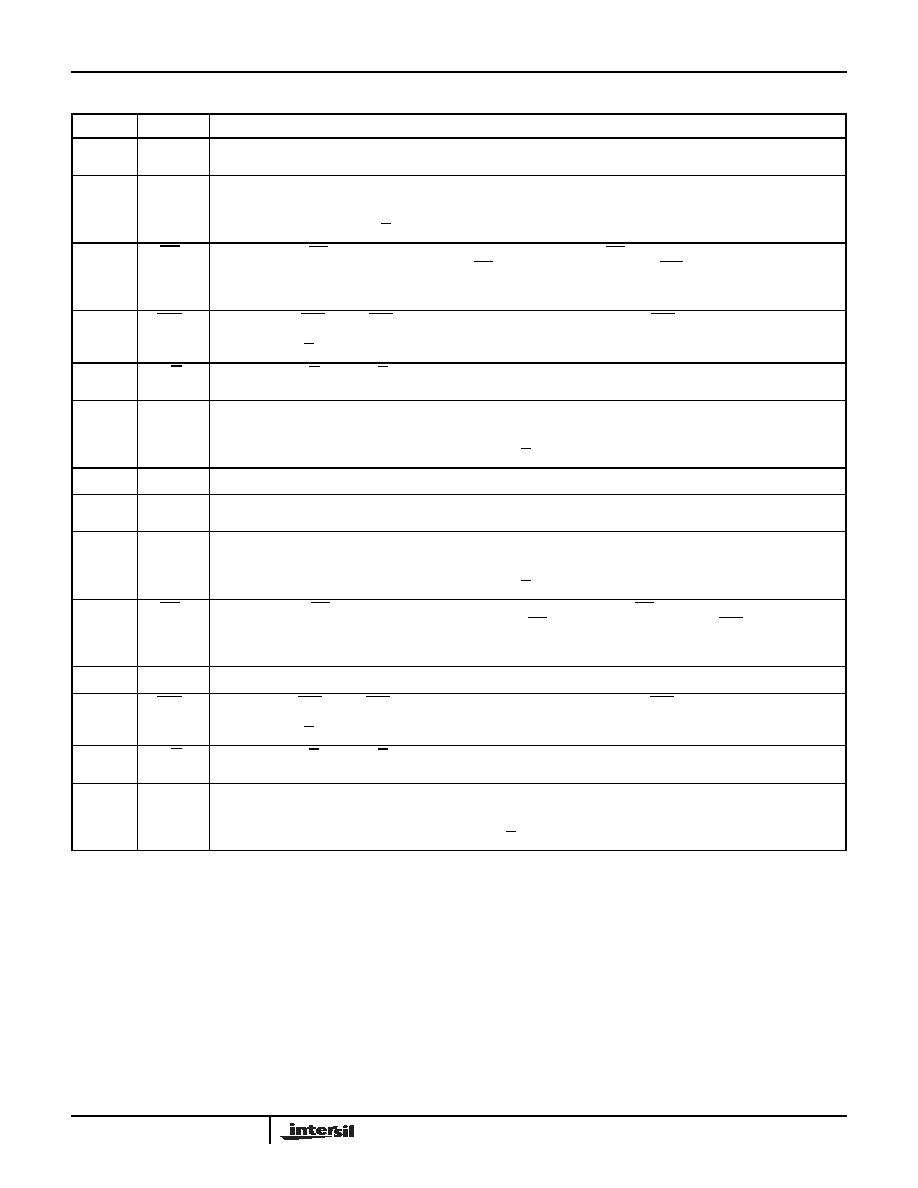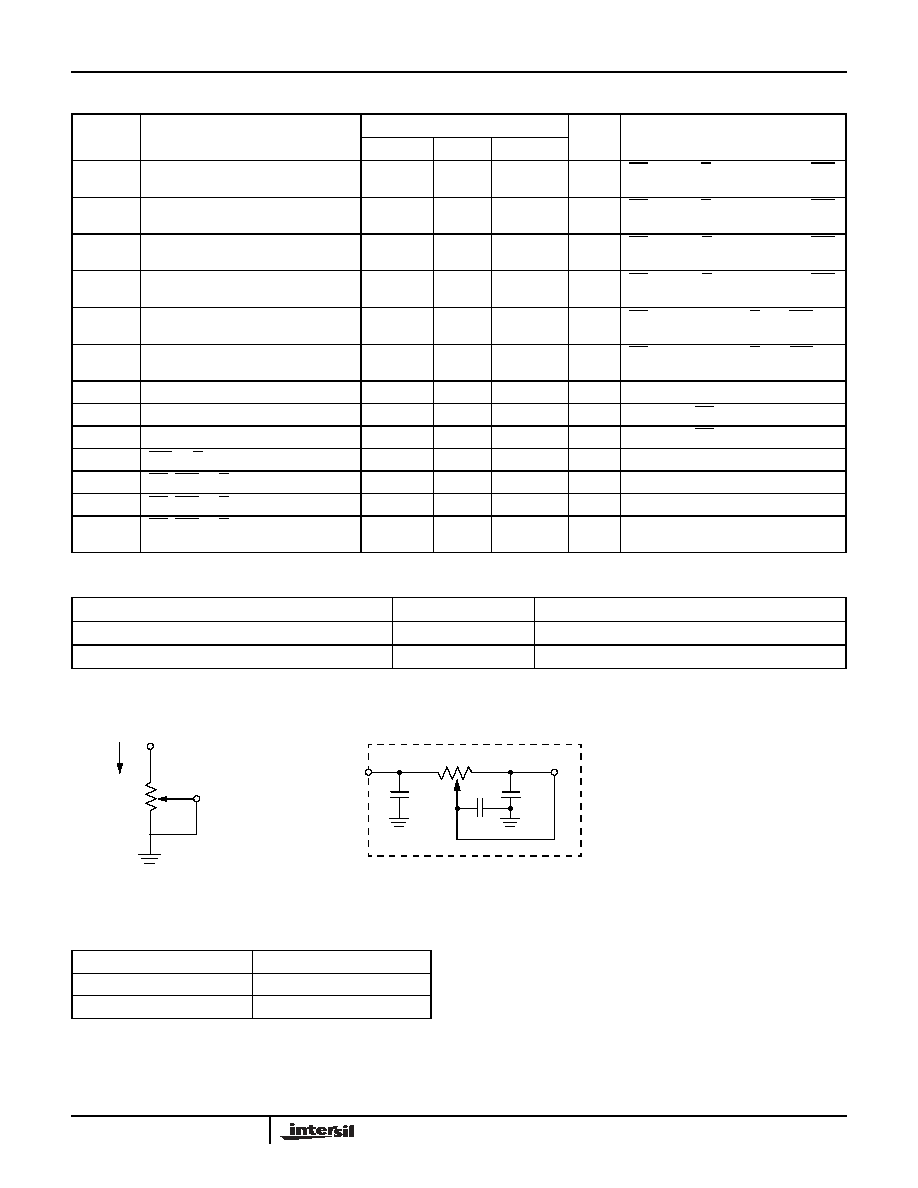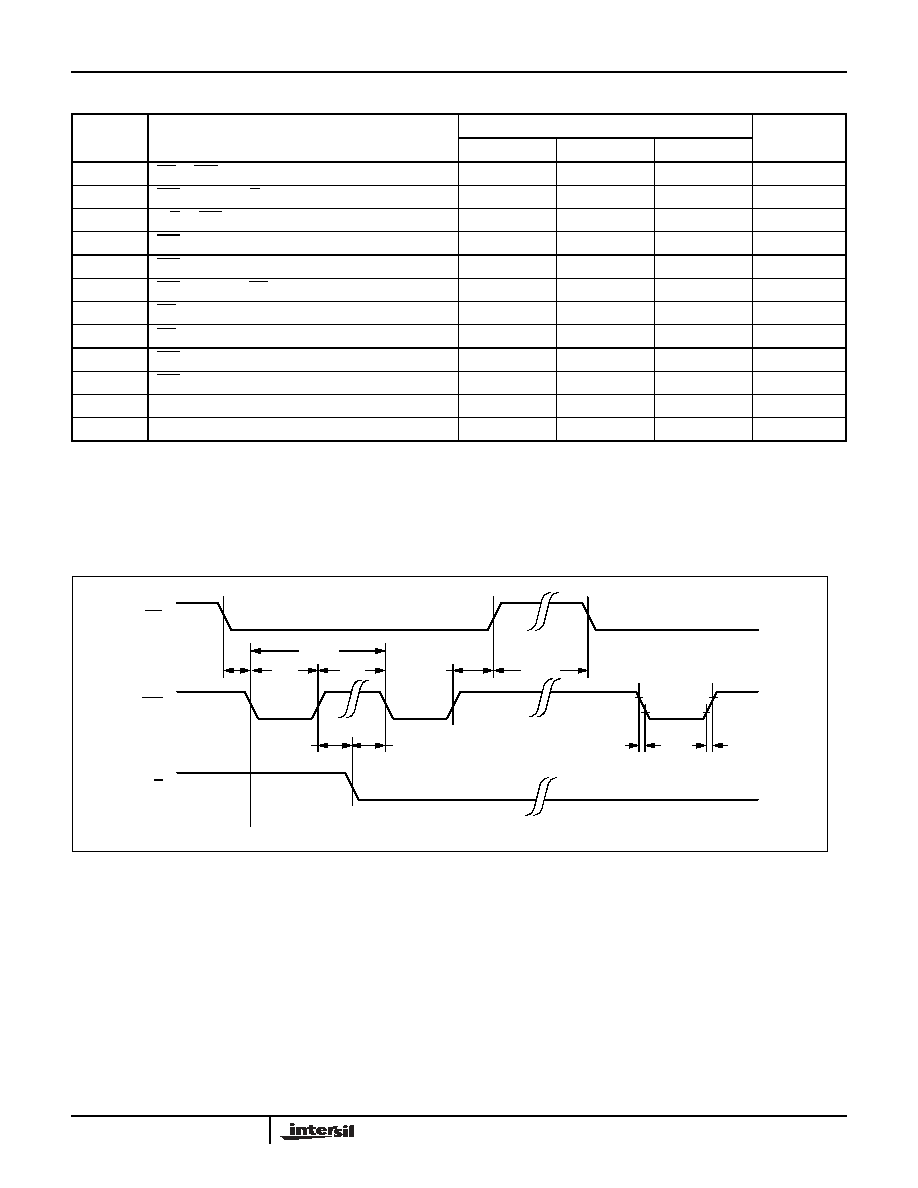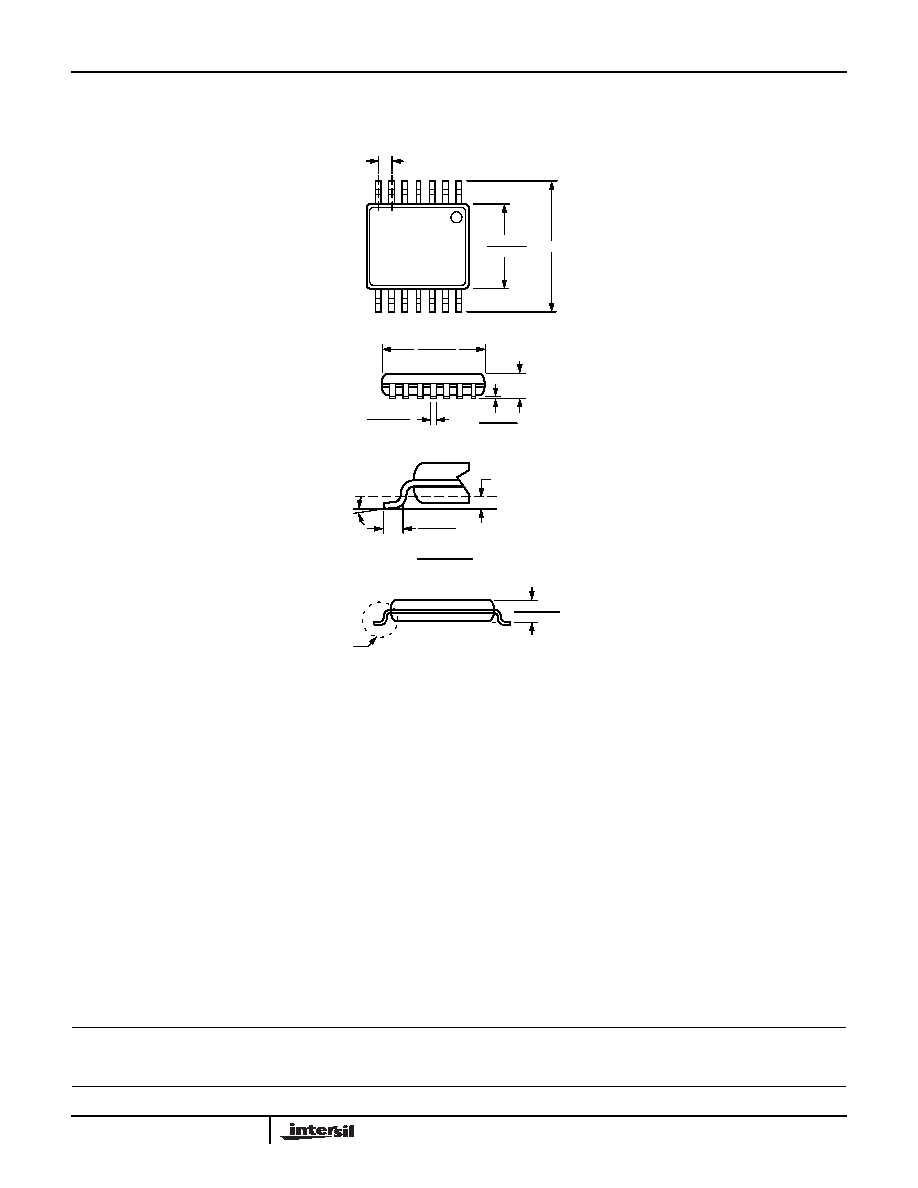 | –≠–ª–µ–∫—Ç—Ä–æ–Ω–Ω—ã–π –∫–æ–º–ø–æ–Ω–µ–Ω—Ç: X93256 | –°–∫–∞—á–∞—Ç—å:  PDF PDF  ZIP ZIP |

1
Æ
FN8188.0
CAUTION: These devices are sensitive to electrostatic discharge; follow proper IC Handling Procedures.
1-888-INTERSIL or 1-888-352-6832
|
Intersil (and design) is a registered trademark of Intersil Americas Inc.
XDCP is a trademark of Intersil Americas Inc. Copyright Intersil Americas Inc. 2005. All Rights Reserved
All other trademarks mentioned are the property of their respective owners.
X93256
Dual Digitally Controlled Potentiometers
(XDCPsTM)
FEATURES
∑ Dual solid-state potentiometers
∑ Individual Up/Down interfaces
∑ 32 wiper tap points per potentiometer
--Wiper position stored in nonvolatile memory
and recalled on power-up
∑ 31 resistive elements per potentiometer
--Temperature compensated
--Maximum resistance tolerance of ± 25%
--Terminal voltage, 0 to V
CC
∑ Low power CMOS
--V
CC
= 2.7 V - 5.5 V.
--Active current, 200µA typical per potentiometer
--Standby current, 4µA max per potentiometer
∑ High reliability
--Endurance 200,000 data changes per bit
--Register data retention, 100 years
∑ R
TOTAL
value = 12.5k
, 50k
∑ Packages
--14-lead TSSOP
DESCRIPTION
The Intersil X93256 is a dual digitally controlled
potentiometer (XDCP). The device consists of two
resistor arrays, wiper switches, a control section, and
nonvolatile memory. The wiper positions are controlled
by individual Up/Down interfaces.
A potentiometer is implemented by a resistor array
composed of 31 resistive elements and a wiper switching
network. The position of each wiper element is controlled
by a set of independent CS, U/D, and INC inputs. The
position of the wiper can be stored in nonvolatile memory
and then be recalled upon a subsequent power-up
operation.
Each potentiometer is connected as a three-terminal
variable resistor and can be used in a wide variety of
applications including:
≠ bias and gain control
≠ LCD Contrast Adjustment
BLOCK DIAGRAM
5-Bit
Up/Down
Counter
5-Bit
Nonvolatile
Memory
Store and
Recall
Control
Circuitry
One
of
Decoder
Resistor
Array
R
H1
U/D
1
INC
1
CS
1
Transfer
Gates
Thirty
V
CC
V
SS
R
L1
General Description
Detailed Single Potentiometer Description
0
1
2
28
29
30
31
Two
Control
and
Memory
Up/Down
(U/D
1
& U/D
2
)
Increment
(INC
1
& INC
2
)
Device Select
(CS
1
& CS
2
)
V
CC
(Supply Voltage)
V
SS
(Ground)
R
H1
R
L1
30K
R
H2
R
L2
R
W
R
W1
R
W2
Data Sheet
March 4, 2005

2
FN8188.0
March 4, 2005
PIN CONFIGURATION
X93256 ORDERING CODES
Ordering Number
RTOTAL
Package
Temperature Range
X93256WV14I-2.7
12.5
k
14-lead TSSOP package
-40∞C to +85∞C
X93256UV14I-2.7
50
k
14-lead TSSOP package
-40∞C to +85∞C
V
CC
CS
1
INC
2
U/D
2
R
H2
V
SS
1
2
3
4
8
7
6
5
X93256
TSSOP
R
L1
*
NC can be left unconnected, or connected to any voltage between V
SS
and V
CC
.
CS
2
INC
1
U/D
1
R
H1
R
L2
14
13
12
11
9
10
Rw1
Rw2
X93256

3
FN8188.0
March 4, 2005
PIN DESCRIPTIONS
TSSOP Symbol
Brief Description
1
R
W1
R
W1
. The R
W1
pin of the X93256 is the wiper terminal of the first potentiometer which is equivalent to the
movable terminal of a mechanical potentiometer.
2
R
L1
R
L1
. The R
H1
and R
L1
pins of the X93256 are equivalent to the fixed terminals of a
mechanical potentiometer. The minimum voltage is V
SS
and the maximum is V
CC
. The terminology of
R
H1
and R
L1
references the relative position of the terminal in relation to wiper movement
direction selected by the U/D input.
3
CS
1
Chip Select 1 (CS
1
). The first potentiometer is selected when the CS
1
input is LOW. The current counter
value is stored in nonvolatile memory when CS
1
is returned HIGH while the INC
1
input is also HIGH. After
the store operation is complete, the first potentiometer of the X93256 will be placed in the low power
standby mode until the first potentiometer is selected once again.
4
INC
2
Increment 2 (INC
2
). The INC
2
input is negative-edge triggered. Toggling INC
2
will move the wiper of the
second potentiometer and either increment or decrement the counter in the direction indicated by the logic
level on the U/D
2
input.
5
U/D
2
Up/Down 2 (U/D
2
). The U/D
2
input controls the direction of the second potentiometer wiper
movement and whether the counter for the second potentiometer is incremented or decremented.
6
R
H2
R
H2
. The R
H
2
and R
L2
pins of the X93256 are equivalent to the fixed terminals of a
mechanical potentiometer. The minimum voltage is V
SS
and the maximum is V
CC
. The terminology of
R
H2
and R
L2
references the relative position of the wiper terminal for the second potentiometer in relation
to the wiper movement direction selected by the U/D
2
input.
7
V
SS
Ground.
8
R
W2
R
W2
. The R
W2
pin of the X93256 is the wiper terminal of the second potentiometer which is
equivalent to the movable terminal of a mechanical potentiometer.
9
R
L2
R
L2
. The R
H2
and R
L2
pins of the X93256 are equivalent to the fixed terminals of a
mechanical potentiometer. The minimum voltage is V
SS
and the maximum is V
CC
. The terminology of
R
H2
and R
L2
references the relative position of the wiper terminal for the second potentiometer in relation
to the wiper movement direction selected by the U/D
2
input.
10
CS
2
Chip Select 2 (CS
2
). The second potentiometer is selected when the CS
2
input is LOW. The current
counter value is stored in nonvolatile memory when CS
2
is returned HIGH while the INC
2
input is also
HIGH. After the store operation is complete, the second potentiometer of the X93256 will be placed in the
low power standby mode until the second potentiometer is selected once again.
11
V
CC
Supply Voltage.
12
INC
1
Increment 1(INC
1
). The INC
1
input is negative-edge triggered. Toggling INC
1
will move the wiper of the
first potentiometer and either increment or decrement the counter in the direction indicated by the logic
level on the U/D
1
input.
13
U/D
1
Up/Down 1 (U/D
1
). The U/D
1
input controls the direction of the first potentiometer wiper movement and
whether the counter for the first potentiometer is incremented or decremented.
14
R
H1
R
H1
. The R
H
1
and R
L1
pins of the X93256 are equivalent to the fixed terminals of a
mechanical potentiometer. The minimum voltage is V
SS
and the maximum is V
CC
. The terminology of
R
H1
and R
L1
references the relative position of the wiper terminal for the first potentiometer in relation to
the wiper movement direction selected by the U/D
1
input.
X93256

4
FN8188.0
March 4, 2005
ABSOLUTE MAXIMUM RATINGS
Temperature under bias .................... -65
∞
C to +135
∞
C
Storage temperature ......................... -65∞C to +150∞C
Voltage on CS, INC, U/D, R
H
, R
L
and V
CC
with respect to V
SS
.............................. -1V to +6.5V
Lead temperature (soldering 10 seconds)......... 300∞C
Maximum reflow temperature (40 seconds) ...... 240∞C
Maximum resistor current..................................... 2mA
COMMENT
Stresses above those listed under "Absolute Maximum
Ratings" may cause permanent damage to the device.
This is a stress rating only; the functional operation of
the device (at these or any other conditions above
those listed in the operational sections of this
specification) is not implied. Exposure to absolute
maximum rating conditions for extended periods may
affect device reliability.
POTENTIOMETER CHARACTERISTICS (Over recommended operating conditions unless otherwise stated.)
Notes: (1) Absolute linearity is utilized to determine actual wiper voltage versus expected voltage = (V
H(n)
(actual) - V
H(n)
(expected)) =
±1 Ml Maximum. n = 1 .. 29 only.
(2) Relative linearity is a measure of the error in step size between taps = V
H(n+1)
- [V
H(n)
+ Ml] = ±0.5 Ml, n = 1 .. 29 only.
(3) 1 Ml = Minimum Increment = R
TOT
/31.
(4) Typical values are for T
A
= 25∞C and nominal supply voltage.
(5) This parameter only applies to a single potentiometer.
(6) Typical parameter is guaranteed by characterization.
(7) When performing multiple write operations, V
CC
must not decrease by more than 150mV from it's initial value.
Symbol
Parameter
Limits
Test Conditions/Notes
Min.
Typ.
Max.
Unit
R
TOT
End to end resistance
9.375
12.5
15.625
k
W option (5)
37.5
50
62.5
k
U option
(5)
V
R
R
H
, R
L
terminal voltages
0
V
CC
V
(5)
Power rating
1
mW
(7)
R
TOTAL
=
50k
(5) (6)
Noise
-120
dBV
(7)
Ref: 1kHz
(5) (6)
R
W
Wiper Resistance
1100
(5) (6)
I
W
Wiper Current
0.6
mA
(5) (6)
Resolution
3
%
(5)
Absolute linearity
(1)
±1
MI
(3)
V
H(n)(actual)
- V
H(n)(expected)
(5)
Relative linearity
(2)
±0.5
MI
(3)
V
H(n+1)
- [V
H(n) + MI
]
(5)
R
TOTAL
temperature coefficient
±35
ppm/∞C
(5) (6)
C
H
/C
L
/C
W
Potentiometer capacitances
10/10/25
pF
(6)
See circuit #2
(5)
RECOMMENDED OPERATING CONDITIONS
Temperature
Min.
Max.
Industrial
-40
∞
C
+85
∞
C
Supply Voltage (V
CC
)
Limits
X93256
2.7V
±
5.5%
(7)
X93256

5
FN8188.0
March 4, 2005
D.C. OPERATING CHARACTERISTICS (Over recommended operating conditions unless otherwise specified.)
ENDURANCE AND DATA RETENTION
A.C. CONDITIONS OF TEST
Symbol
Parameter
Limits
Unit
Test Conditions
Min.
Typ.
(4)
Max.
I
CC1
V
CC
active current (Increment)
50
250
µA
CS = V
IL
, U/D = V
IL
or V
IH
and INC
= 0.4V @ max. t
CYC
V
CC
= 3V
200
300
CS = V
IL
, U/D = V
IL
or V
IH
and INC
= 0.4V @ max. t
CYC
V
CC
= 5V
I
CC2
V
CC
active current (Store)
(EEPROM Store)
600
µA
CS = V
IH
, U/D = V
IL
or V
IH
and INC
= V
IH
@ max. t
WR
V
CC
= 3V
1400
µA
CS = V
IH
, U/D = V
IL
or V
IH
and INC
= V
IH
@ max. t
WR
V
CC
= 5V
I
SB
Standby supply current
1
µA
CS = V
CC
- 0.3V, U/D and INC =
V
SS
or V
CC
- 0.3V V
CC
= 3V
4
µA
CS = V
CC
- 0.3V, U/D and INC =
V
SS
or V
CC -
0.3V V
CC
= 5V
I
LI
CS input leakage current
±1
µA
V
IN
= V
CC
(5)
I
LI
CS input leakage current
60
100
150
µA
V
CC
= 3V, CS = 0
(5)
I
LI
CS input leakage current
120
200
250
µA
V
CC
= 5V, CS = 0
(5)
I
LI
INC, U/D input leakage current
±1
µA
V
IN
= V
SS
to V
CC
(5)
V
IH
CS, INC, U/D input HIGH voltage
V
CC
x 0.7
V
CC
+ 0.5
V
(5)
V
IL
CS, INC, U/D input LOW voltage
-0.5
V
CC
x 0.1
V
(5)
C
IN
(5)(7)
CS, INC, U/D input capacitance
10
pF
V
CC
= 3V, V
IN
= V
SS
, T
A
= 25∞C,
f = 1MHz
(6)
Parameter
Min.
Unit
Minimum endurance
200,000
Data changes per bit
Data retention
100
Years
Input pulse levels
0V to 3V
Input rise and fall times
10ns
Input reference levels
1.5V
Test Circuit #1
Circuit #2 SPICE Macro Model
Test Point
V
H
/R
H
C
H
C
L
10pF
10pF
R
H
R
TOTAL
C
W
25pF
R
L
X93256

6
FN8188.0
March 4, 2005
A.C. OPERATING CHARACTERISTICS (Over recommended operating conditions unless otherwise specified)
POWER UP AND DOWN REQUIREMENTS
There are no restrictions on the power-up or power-down conditions of V
CC
and the voltages applied to the potentiometer
pins provided that V
CC
is always more positive than or equal to V
H
and V
L
, i.e., V
CC
V
H,
V
L
. The V
CC
ramp rate spec is
always in effect.
A.C. TIMING
Symbol
Parameter
Limits
Unit
Min.
Typ.
(6)
Max.
t
Cl
CS to INC setup
100
ns
t
lD
INC HIGH to U/D change
100
ns
t
DI
U/D to INC setup
100
ns
t
lL
INC LOW period
1
µs
t
lH
INC HIGH period
1
µs
t
lC
INC Inactive to CS inactive
1
µs
t
CPH
CS Deselect time (NO STORE)
250
ns
t
CPH
CS Deselect time (STORE)
10
ms
t
CYC
INC cycle time
2
µs
t
R
,
t
F
(6)
INC input rise and fall time
500
µs
t
R
V
CC
(6)
V
CC
power-up rate
0.2
10,000
V/ms
t
WR
Store cycle
5
10
ms
CS
INC
U/D
t
CI
t
IL
t
IH
t
CYC
t
ID
t
DI
t
IC
t
CPH
t
F
t
R
10%
90%
90%
(Store)
X93256

7
FN8188.0
March 4, 2005
PIN DESCRIPTIONS
(In the text, CS, INC, U/D, R
H
, R
W
, and R
L
are used to
refer to either CS
1
or CS
2
, etc. Note: These signals can
be applied independently or at the same time.)
R
H
and R
L
The R
H
and R
L
pins of the X93256 are equivalent to the
fixed terminals of a mechanical potentiometer. The
minimum voltage is V
SS
and the maximum is V
CC
. The
terminology of R
H
and R
L
references the relative position
of the terminal in relation to wiper movement direction
selected by the U/D input per potentiometer.
R
W
The R
W
pin of the X93256 is the wiper terminal of the
potentiometer which is equivalent to the movable terminal of
a mechanical potentiometer
Up/Down (U/D)
The U/D input controls the direction of a single
potentiometer's wiper movement and whether the
counter is incremented or decremented.
Increment (INC)
The INC input is negative-edge triggered. Toggling INC
will move the wiper and either increment or decrement
the pertatining potentiometer's counter in the direction
indicated by the logic level on the pertaining
potentiometer's U/D input.
Chip Select (CS)
A potentiometer is selected when the pertaining CS input
is LOW. Its current counter value is stored in nonvolatile
memory when the pertaining CS is returned HIGH while
the pertaining INC input is also HIGH. After the store
operation is complete the affected potentiometer will be
placed in the low power standby mode until the
potentiometer is selected once again.
PRINCIPLES OF OPERATION
There are multiple sections for each potentiometer in the
X93256: an input control, a counter and decode section;
the nonvolatile memory; and a resistor array. Each input
control section operates just like an up/down counter.
The output of this counter is decoded to turn on a single
electronic switch connecting a point on the resistor array
to the wiper output. Under the proper conditions the
contents of the counter can be stored in nonvolatile
memory and retained for future use. Each resistor array
is comprised of 31 individual resistors connected in
series. At either end of the array and between each
resistor is an electronic switch that transfers the
connection at that point to the wiper.
Each wiper, when at either fixed terminal, acts like its
mechanical equivalent and does not move beyond the
last position. That is, the counter does not wrap around
when clocked to either extreme.
If the wiper is moved several positions, multiple taps are
connected to the wiper for t
IW
(INC to V
W
change). The
2-terminal resistance value for the device can temporarily
change by a significant amount if the wiper is moved
several positions.
When the device is powered-down, the last wiper
position stored will be maintained in the nonvolatile
memory for each potentiometer. When power is
restored, the contents of the memory are recalled and
each wiper is set to the value last stored.
X93256

8
FN8188.0
March 4, 2005
INSTRUCTIONS AND PROGRAMMING
The INC, U/D and CS inputs control the movement of the
pertaining wiper along the resistor array. With CS set
LOW the pertaining potentiometer is selected and
enabled to respond to the U/D and INC inputs. HIGH to
LOW transitions on INC will increment or decrement
(depending on the state of the U/D input) a five bit
counter. The output of this counter is decoded to select
one of thirty two wiper positions along the resistive array.
The value of the counter is stored in nonvolatile memory
whenever each CS transitions HIGH while the pertaining
INC input is also HIGH. In order to avoid an accidental
store during power-up, each CS must go HIGH with V
CC
during initial power-up. When left open, each CS pin is
internally pulled up to V
CC
by an internal 30K resistor.
The system may select the X93256, move any wiper and
deselect the device without having to store the latest
wiper position in nonvolatile memory. After the wiper
movement is performed as described above and once
the new position is reached, the system must keep INC
LOW while taking CS HIGH. The new wiper position will
be maintained until changed by the system or until a
power-up/down cycle recalled the previously stored data.
In order to recall the stored position of the wiper on
power-up, the CS pin must be held HIGH.
This procedure allows the system to always power-up to
a preset value stored in nonvolatile memory; then during
system operation minor adjustments could be made. The
adjustments might be based on user preference, system
parameter changes due to temperature drift, or other
system trim requirements.
The state of U/D may be changed while CS remains
LOW. This allows the host system to enable the device
and then move each wiper up and down until the proper
trim is attained.
MODE SELECTION
SYMBOL TABLE
CS
INC
U/D
Mode
L
H
Wiper Up
L
L
Wiper Down
H
X
Store Wiper Position
H
X
X
Standby Current
L
X
No Store, Return to Standby
L
H
Wiper Up (not recommended)
L
L
Wiper Down (not recommended)
WAVEFORM
INPUTS
OUTPUTS
Must be
steady
Will be
steady
May change
from Low to
High
Will change
from Low to
High
May change
from High to
Low
Will change
from High to
Low
Don't Care:
Changes
Allowed
Changing:
State Not
Known
N/A
Center Line
is High
Impedance
X93256

9
All Intersil U.S. products are manufactured, assembled and tested utilizing ISO9000 quality systems.
Intersil Corporation's quality certifications can be viewed at www.intersil.com/design/quality
Intersil products are sold by description only. Intersil Corporation reserves the right to make changes in circuit design, software and/or specifications at any time without
notice. Accordingly, the reader is cautioned to verify that data sheets are current before placing orders. Information furnished by Intersil is believed to be accurate and
reliable. However, no responsibility is assumed by Intersil or its subsidiaries for its use; nor for any infringements of patents or other rights of third parties which may result
from its use. No license is granted by implication or otherwise under any patent or patent rights of Intersil or its subsidiaries.
For information regarding Intersil Corporation and its products, see www.intersil.com
FN8188.0
March 4, 2005
TSSOP PACKAGING INFORMATION
NOTE: ALL DIMENSIONS IN INCHES (IN PARENTHESES IN MILLIMETERS)
14-Lead Plastic, TSSOP, Package Code V14
See Detail "A"
.031 (.80)
.041 (1.05)
.169 (4.3)
.177 (4.5) .252 (6.4) BSC
.025 (.65) BSC
.193 (4.9)
.200 (5.1)
.002 (.05)
.006 (.15)
.041 (1.05)
.0075 (.19)
.0118 (.30)
0∞ - 8∞
.010 (.25)
.019 (.50)
.029 (.75)
Gage Plane
Seating Plane
Detail A (20X)
X93256








